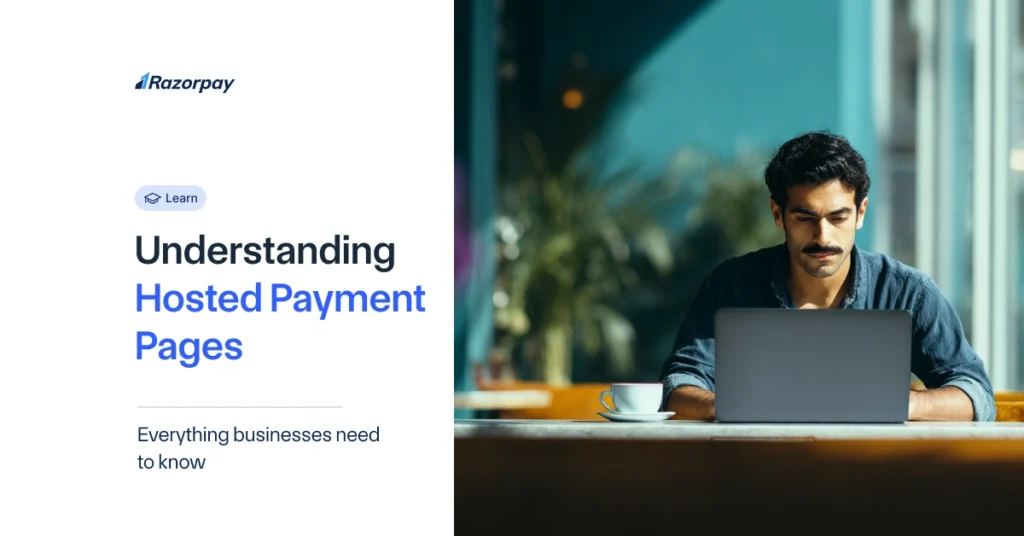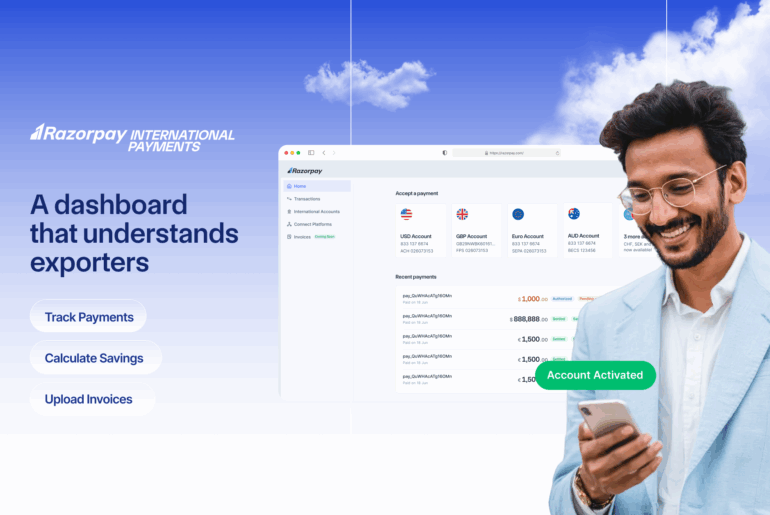India’s mobile payments jumped nearly 30% year-on-year to ₹198 lakh crore in the second half of 2024, driven largely by UPI transactions. With this surge, one thing is clear — customers want quick, safe, and hassle-free ways to pay online. But for business owners, keeping payments secure without extra stress can be a real challenge. A hosted payment page takes this worry away. It lets you accept payments easily while keeping your customers’ data safe — all without needing complex systems or heavy security work on your end.
Table of Contents
What Is a Hosted Payment Page?
A hosted payment page is a secure web page provided by a third-party payment provider. When your customers are ready to pay, they are sent to this page to enter their card or UPI details.
This means you do not collect or store any payment information on your own website. Using a hosted pay page keeps your business away from handling sensitive data and helps you meet PCI DSS rules more easily.
How Does a Hosted Payment Page Work?
When you use a hosted payment page, your checkout process becomes simple and secure. Here’s how it works.
-
At checkout, your customer clicks the payment button on your website.
-
Instead of entering card details on your site, they are sent to a secure hosted payment page provided by a trusted payment gateway.
-
On this page, the customer fills in their payment details — like card number, UPI ID, or net banking information.
-
The hosted pay page collects this information and sends it straight to the payment processor. Your own servers never handle or store any sensitive data.
-
After the payment is done, the customer comes back to your website with a success or failure message.
This hosted web integration keeps your checkout PCI DSS compliant and lowers the risk of fraud.
Key Benefits of Hosted Payment Pages for Businesses
-
Keeps Customer Data Secure: A hosted payment page keeps all payment details away from your own website. Your customers enter their card or banking info on a secure page handled by a trusted provider. This reduces your exposure to data breaches and fraud. In fact, with 79% of organisations reporting payment fraud attempts in 2024, strong security has become a basic need for every business that accepts payments online.
-
Makes PCI DSS Compliance Easier: Meeting PCI DSS rules can be costly and time-consuming. With a hosted pay page, the payment provider manages most security requirements. This saves you time, money, and effort while keeping you compliant.
-
Builds Customer Trust: When you use a trusted hosted checkout, your customers feel safer sharing their payment details. A smooth, secure payment page shows that you care about their data privacy. This trust can lead to more repeat purchases.
-
Quick and Simple to Set Up: A hosted web integration is easy to add to your site. You do not need to build or maintain a payment gateway yourself. The provider handles updates, security, and support, so you can focus on running your business.
Key Features Of a Hosted Payment Page
1. Strong Security: A hosted payment page uses advanced security tools like encryption and fraud checks to protect payment details. This keeps your customers’ card or UPI data safe and reduces the chance of data leaks.
2. Easy To Customise: You can match the payment page with your brand by adding your logo, colours, and style. A familiar, branded checkout builds trust and makes customers feel more comfortable paying online.
3. Automatic Updates And Maintenance: Your payment provider takes care of all security updates, compliance checks, and system upgrades for you, so you don’t have to handle these tasks yourself. This saves you time and ensures that your hosted payment page always stays secure and up to date.
4. Multiple Payment Methods: A good hosted pay page supports cards, UPI, net banking, and wallets. This gives your customers more choice and makes it easier for you to get paid on time.
How to Choose the Right Hosted Payment Page Provider?
-
Look for Strong PCI Compliance: Your provider must follow PCI DSS rules at all times. This keeps your customers’ payment data safe and lowers your security risks. Well-known providers meet strict standards and offer trusted protection for businesses of all sizes.
-
Check Payment Methods Supported: Make sure the hosted pay page supports all popular payment options. This includes cards, UPI, net banking, and wallets. A payment gateway such as Razorpay supports multiple payment methods, giving your customers more ways to pay and helping you complete more transactions successfully.
-
Check Ease of Integration: Choose a provider that is easy to connect with your website or app. A good hosted web integration should not need complicated coding or extra effort. Look for clear step-by-step guides, ready plugins, and quick help if you face any problems.
-
Look for Customisation Options: Your hosted payment page should match your brand style. See if you can add your logo, brand colours, or extra fields. A familiar look builds trust and makes customers feel comfortable while paying.
-
Ensure Mobile Optimisation: Many people pay using their phones. Pick a hosted checkout that works well on all screen sizes. A payment page that loads fast and looks good on mobile helps avoid failed payments.
-
Reliable Support: Good customer support is important if something goes wrong. Choose a provider that offers quick help through chat, email, or phone. Fast and clear support can save you time and avoid payment delays.
-
Clear and Fair Pricing: Compare transaction charges, setup fees, and any hidden costs. Look for simple pricing plans with no surprises later. A clear fee structure helps you manage your costs better as your business grows.
-
Ask the Right Questions: Before you sign up, ask about uptime, settlement times, refunds, and fraud prevention. This helps you know what to expect. Always read reviews and test the payment flow yourself to be sure it works well for your customers.
How to Set Up a Hosted Payment Page for Your Business?
-
Choose A Trusted Payment Provider: First, pick a reliable payment processor that offers a secure checkout page. Make sure it supports payment methods your customers prefer, like cards, UPI, or wallets. Always check that the provider follows PCI DSS rules and has good customer support.
-
Register And Set Up Your Merchant Account: Next, sign up with your chosen provider and complete the registration process. You’ll need to share your business documents, bank account details, and other information to set up your merchant account properly.
-
Customise Your Payment Page: Once your account is active, customise the payment page to match your brand. Add your logo, brand colours, and choose which payment options you want to offer. A familiar look makes customers feel safe and confident while paying.
-
Integrate With Your Website: Now, link the payment page to your website. You can do this easily with an API, a plugin, or a simple code snippet provided by your payment partner. This ensures that when customers click ‘Pay Now’, they are redirected to the secure checkout page without any confusion.
-
Test the Payment Flow: Before going live, always test the payment flow. Use the sandbox mode to run test transactions and see how the process works from start to finish. This helps you fix any errors before real customers use it.
-
Go Live and Monitor Payments: After testing, switch to live mode and start accepting payments. Keep an eye on your transactions, check for any failed payments, and make sure your checkout works well on both desktop and mobile devices.
Tips For a Smooth Setup:
-
Explain to your customers that they will be redirected to a secure payment page — this builds trust.
-
Test the payment page on different devices to make sure it works well everywhere.
-
Regularly update your branding if your logo or colours change.
Common Pitfalls To Avoid:
-
Never skip testing — payment errors can make you lose sales and trust.
-
Avoid providers that do not clearly follow PCI DSS rules.
-
Do not forget to monitor your payment reports regularly to catch any issues early.
Conclusion
Using a hosted payment page gives your business a secure and simple way to accept online payments without handling sensitive data yourself. It keeps your checkout safe and PCI DSS compliant while saving you the trouble of building a complex payment system from scratch.
With easy integration and the option to customise the page with your brand, you can offer customers a smooth and trusted payment experience. As your business grows, a hosted payment page helps you handle more transactions safely and gives you more time to focus on scaling your business, not managing payment risks.
FAQs
Q1. Is a hosted payment page secure?
Yes, a hosted payment page is very secure. It is managed by a trusted payment provider that uses strong encryption, fraud checks, and follows PCI DSS rules to keep your customers’ payment data safe.
Q2. How is a hosted payment page different from other payment methods?
Unlike collecting payments directly on your site, a hosted payment page redirects customers to a secure page handled by a payment provider. This means you do not store or manage any card details yourself, reducing security risks and making compliance easier.
Q3. Why should a business use a hosted payment page?
Using a hosted pay page helps you accept online payments securely without building your own payment system. It saves you time, lowers your security burden, and gives your customers a smooth checkout experience.
Q4. What types of businesses can benefit from a hosted payment page?
Any business that sells online can benefit — whether you run an e-commerce store, offer online services, or collect donations. Small businesses and startups especially find it useful because it removes the need for heavy tech work and security management.
Q5. How can a business set up a hosted payment page?
You can set up a hosted payment page by:
-
Choosing a reliable payment provider
-
Registering and verifying your merchant account
-
Customising the checkout page with your branding
-
Connecting the page to your website using a plugin, API, or code snippet
-
Testing the payment flow in sandbox mode
-
Going live and starting to accept payments
Q6. Are hosted payment pages customisable?
Yes, you can customise your hosted checkout page with your logo, colours, and preferred payment methods. A branded page builds trust and keeps the checkout experience familiar for your customers.
Q7. Do hosted payment pages offer recurring billing options?
Yes, many hosted payment pages support recurring payments for subscriptions or regular services. You can check with your provider to see if they offer this feature.
Q8. Can a hosted payment page accept multiple payment methods?
Yes, most hosted payment pages let you accept various payment methods like credit and debit cards, UPI, wallets, and net banking. This makes it easy for your customers to choose how they want to pay.
Q9. What is the role of a hosted payment page in PCI compliance?
A hosted payment page keeps sensitive payment data off your own servers. The payment provider handles all card information securely, which makes it much easier for you to meet PCI DSS requirements without extra work or high costs.


